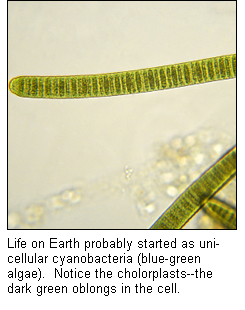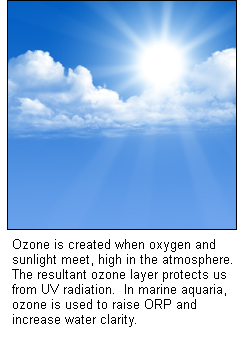Revisited: Your Guide to OXYGEN

Background:
Oxygen is a crazy little element. It is like the frenemy of the biochemical world. Without oxygen few organisms but bacteria can survive. Yet, take in too much oxygen, and it can literally destroy your tissues. In the atmosphere, oxygen (O2) reacts to block harmful high-energy solar radiation. In seawater, oxygen plays an important role in oxidizing waste materials. Oh yeah, I forgot to say that animals all need it to breathe too! Oxygen is particularly important in the marine realm, where its poor solubility in saltwater means it always exists in a finely-balanced state. Dissolved oxygen is thus a subject that concerns marine aquarists a great deal, yet it is often under-emphasized. That is why it is the topic of discussion for this edition of Chemistry Corner.

In the beginning, there wasno oxygen!?! Actually, that does not tell the whole story. In the beginning, when Earth was still dominated by extreme volcanism, virtually no free oxygen molecules are thought to have been present. It is likely that most were taken up rapidly in reactions with iron-rich volcanic ejecta. An interesting side effect of this lack of oxygen is that there could have been no ozone layer. The primordial Earth was thus awash in harmful Ultraviolet (UV) radiation that could very well have contributed to the creation of the first organic molecules. Over billions of years, these organic molecules assembled into living organisms (anaerobic, of course), some of which began to use sunlight as an energy source for photosynthesis. In due time the byproduct of photosynthesis, oxygen, began to accumulate in the atmosphere in high enough quantities to change the course of evolution, forever.
The evolution of photosynthesis was enabled by an early Earth-atmosphere rich in carbon dioxide (CO2). During the photosynthetic process, CO2 is split into its constituent atoms, carbon and oxygen. The byproducts, sugar and oxygen, have very different destinies. Sugar becomes the basis of the food web, while oxygen has a world of possibilities ahead of it. Oxygenonce a third-rate atmospheric gasgrew to rival carbon as the one of the most influential elements in the history of life on Earth.
Oxygen has four main affects on this planet. First, in the form of ozone (O3), it protects the Earths surface from dangerous radiation. Second, as a terminal electron acceptor, it is the ultimate destination for electrons used to facilitate metabolic reactions. Third, as an oxidizer, it is a highly corrosive chemical that enables the recycling of biological material, especially in the marine environment. Fourth, the presence of oxygen has forced organisms it poisons (e.g. anaerobic microbes) to the most marginal of habitats, ensuring that aerobic organisms dominate the most hospitable areas.

As Ozone:
Atmospheric oxygen, especially at lower altitudes, is usually found in its diatomic state. That is, it is two oxygen atoms bonded together as a molecule. Though this is the biologically significant form, it is not the only one. When energetic solar radiation enters the atmosphere, it strikes O2 molecules, which are split apart in the process. As free ions, the oxygen molecules are very reactive, and some of them come together with whole oxygen molecules to form ozone, O3. Ozone has the wonderful benefit of filtering out UV radiation, thereby protecting the Earths surface from inundation. In spite of its benefits, ozone is a deadly gas. Luckily, it tends to stay high in the atmosphere, away from possible exposure to animals.
As Electron Acceptor:
Perhaps no other aspect of oxygen is as fundamentally important as its role as the terminal electron receptor in a cells electron transport chain. When oxygen is present, a cells mitochondria use it to help pump protons against their concentration gradient. In so doing, the protons are put into a high-energy state. When they fall back down, the energy they release is trapped in power molecules the cell then uses as batteries. Without oxygen, cells can still metabolize for short times, but in a much less efficient manner. Oxygenated electron transport (oxidative phosphorylation) can produce nearly ten times as much energy per cycle as the anoxic alternative, fermentation.
The process of cellular respiration, of which oxidative phosphorylation is a major part, has been a driving evolutionary force throughout much of biological history. Once this mechanism was created, speciation occurred at an immense rate. The huge increase in energy production enabled organisms to use spare energy for other things, like evolving new attributes and intellects. It is no small wonder, then, that the way an animal takes in its oxygen is one of the most fundamentally defining of its characteristics.
As a Redox Chemical:
In truth, oxidative phosphorylation is a form of oxidation-reduction (redox) reaction (one in which electrons are transferred from reducers to oxidizers). However, there is another critical way in which oxygen acts as an oxidizer. In redox reactions in seawater, toxic nitrogenous wastes are converted into less harmful, and more useful, chemicals. The pathways by which these conversions happen are convoluted and may require many complex chemical steps. Yet, oxygen tends to be at the center of many of the reactions. In spite of the fact that oxygen is a very small molecule, it makes up for it by showing up in massive numbers. Even in seawater, where the dissolved salts leave less room for oxygen than what is available in fresh, the absolute number of oxygen molecules is staggering. Moreover, there are numerous other oxygen species that form in seawater, all of which contribute some oxidizing power.

The Consequences of Too Little Oxygen:
It goes without saying that animals need oxygen to stay alive. In hypoxic or anoxic conditions, animals and some bacteria are unable to produce enough metabolic energy to survive. In aquarium settings, beneficial aerobic bacteria are the first to perish without oxygen. Such a situation quickly becomes critical because a series of dangerous events rapidly begins to unfold. The aerobes start to decompose, which removes even more dissolved oxygen (DO) from the water. After that, it is only a short time before invertebrates, then fish, begin to succumb. Sadly, this scenario can play itself out in only a few hours under the right circumstances, which are initialized when DO drops below 5 mg/L.
The Consequences of Too Much Oxygen:
In contrary to a popular clich, you can have too much of a good thing. Oxygen, while deadly in low levels, is equally deadly when the levels are too high. If something causes a spike in oxygen, several problems can result. For example, when DO is excessive, fish can suffer problems from the gas. If DO is too high for too long, fish can get afflictions like popeye, which occurs when a gus bubble forms in or behind the eye. Or, if there are superfluous micro air-bubbles in the water column, they can actually asphyxiate if their gills become covered in bubbles. ORP is also raised by dissolved O2, and the increased potential can cause death in fish, invertebrates, and even beneficial bacteria. In fact, many photosynthetic corals are able to use fluorescent pigments to shield their algae from too much light, thereby preventing oxygen levels from building to dangerous oxidative levels in their tissues. However, they have no control over the ambient water conditions to which they are subjected.

Maintaining Oxygen:
The only times you are likely to have a problem with low O2 levels are during power outages and when fish are overstocked. On the opposite end of the spectrum, too much O2 can be caused in rare cases. Protein skimmers, for one, can release micro air-bubbles into the system. These can go on to interfere with fish respiration, as well as cause necrosis in sponges. In the case of ozone overdose, oxygen becomes deadly through its oxidative power. Luckily, even though the penalties for sub- or supra-optimal oxygen conditions are severe, the prevention is easy.
Most aquaria are actually already equipped to maintain good oxygenation, by default. The simplest way to achieve it is through vertical circulation. As long as water is constantly circulated down from the surface and back, DO will be brought to all of the organisms in need. Good circulation is easily achieved in a tank that is longer than it is tall, but tanks built the opposite way require more water movement to ensure adequate oxygen distribution. Secondarily, water traveling down an overflow bulkhead, trickled over bioballs, or run through a skimmer gets a significant oxygen boost. The typically shallower nature of a sump ensures that water flowing through it is exposed to fresh air as well. If the water also travels through a refugium, it will pick up additional O2 from the photosynthesizing macroalgae. On top of all that, corals that photosynthesize also contribute a small amount of O2 to the sum.
Summary:
Oxygen, in spite of its fickle nature, is a necessary evil. An anti-hero, of sorts. Keep on its good side, and it will keep you in good health. Get on its bad side, though, and it will kill you (or your livestock, as it were). The good news for us aquarists is that as long as our pumps keep running, we do not even need to think about dissolved oxygen. It is self-repairing problem that is difficult to screw up. Just beware is something does go wrong; it can do so in a great hurry.
Works Cited:
Castro, P. and M.E. Huber. Marine Biology, 5th Edition. McGraw Hill: Boston. 2005.
Brightwell, C.R. Marine Chemistry; A Complete Guide to Water Chemistry in Marine Aquariums. TFH Publications: Neptune City. 2007.
Edelman, E. Redox and ORP. Reefs Online. 1997. URL: < http://www.reefs.org/library/talklog/e_edelman_08... >
Farley, R.H. ORP and the Reef Aquarium. Reefkeeping Online Magazine. Dec. 2003. URL: < http://reefkeeping.com/issues/2003-12/rhf/feature... >
Farley, R.H. Ozone and the Reef Aquarium, Part 1: Chemistry and Biochemistry. Reefkeeping Online Magazine. June 2003. URL: < http://reefkeeping.com/issues/2006-03/rhf/index.p... > Goemans, B. and L. Ichinotsubo. The Marine Fish Health and Feeding Handbook; The Essential Guide to Keeping Saltwater Species Alive and Thriving. TFH Publications: Neptune City. 2008.
Thurman, H.V. and A.P. Trujillo. Introductory Oceanography, 10th Edition. Pearson Prentice Hall: Upper Saddle River. 2004.
Silberberg, M.S. Chemistry; the Molecular Nature of Matter and Change, 3rd Edition. McGraw Hill: Boston. 2003.